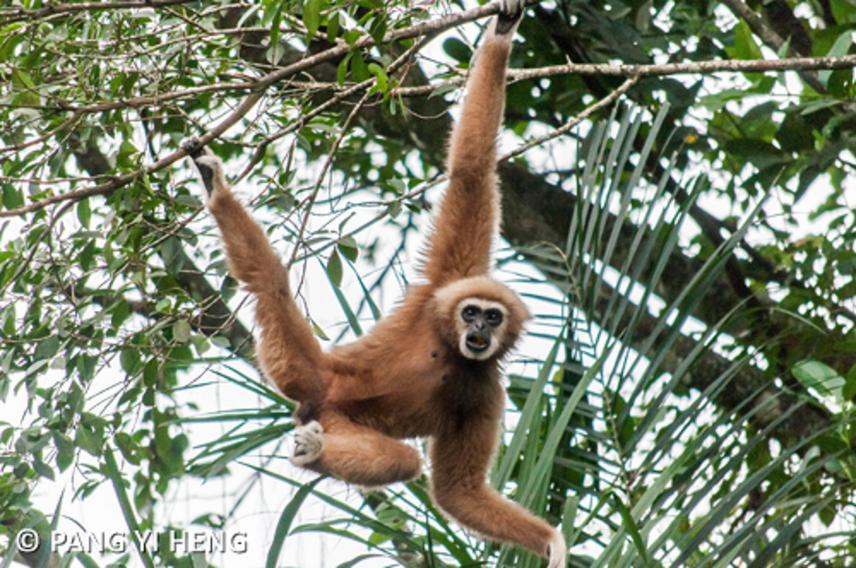Pang Yi-Heng
Most agile gibbon (Hylobates agilis) habitat in Malaysia has been converted for other land uses. Detailed knowledge of their abundance and habitat preferences is required for effective conservation management. To assess the relationship between ecological variables and gibbon population densities, I will conduct acoustic surveys in Ulu Muda to estimate gibbon abundance, evaluate habitat characteristics using vegetation “speed plots”, then compare group densities in unlogged, recently-logged and historically-logged forests. I predict that habitat characteristics will be related to gibbon densities. Understanding the impact of logging on agile gibbon densities will help predicting the effect of logging on endangered arboreal frugivores.

Like agile gibbon (Hylobates agilis), which is the target species of this project, lar gibbon (Hylobates lar) uses its long arms to brachiate from branches to branches. ©Pang
Gibbons are known to tolerate some disturbance and persist in secondary/degraded forests, though their densities tend to be higher in less-disturbed forests. There are previous and on-going researches of various species of gibbons being done in Thailand and Sumatra, primarily focusing on their diet, behaviour, abundance and distribution with regards to forest types. However, similar studies done on gibbons throughout Malaysia is lacking, since the last publication about gibbons in Malaysia was in 1980s. Therefore, the current population estimate and distribution range of gibbons in Malaysia is unknown.
The goal of this study is to contribute valuable data about agile gibbon (Hylobates agilis) abundance, density, distribution and responses to habitat disturbance to inform the development of effective conservation programs for gibbons and their habitats. I plan to collect field data for approximately 6 months, with two months allocated for each forest type: unlogged primary forest, previously-logged forest and recently-logged forest. In each forest type, I plan to conduct acoustic surveys at three sites in each habitat type. In each sites, I will establish three listening posts and 10 vegetation “speed plots”. Depending on the forest cover and the terrain, the area sampled in each listening area should cover approximately 4 km2. On each sampling trip, my research assistants and I will collect both acoustic and vegetation data from one of the nine listening areas.
At the conclusion of the study, we will collaborate with Malaysian wildlife authorities to develop a feasible action plan for protecting viable populations of gibbons in both protected and unprotected forests. Thus, more evidence is needed to support the idea of including forest reserve and other unprotected areas into the protection plan, before the continuous destruction and degradation of the habitat decimate the gibbons’ existence in Malaysia. With sufficient data and action plan, some of the unprotected areas, Ulu Muda Forest Reserve for example, stands a chance to become a totally-protected state park.
This study will also be educating the general public to appreciate the significance of gibbons towards the forest and vice versa, and be compelled to protect nature and practice sustainability. The project will also raise awareness with regard to the illegal pet trade, which gibbons regularly suffer. Outreach programs will be conducted for students from various local schools in Penang and Kedah state. Games, role-playing and story-telling will be used to convey the message. Pre- and post-program questionnaires will be conducted to evaluate the change in student’s perception on gibbon conservation issues.